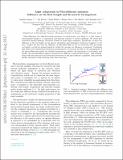Light Adaptation in Phycobilisome Antennas: Influence on the Rod Length and Structural Arrangement
Author(s)
Keren, Nir; Paltiel, Yossi; Nevo, Reinat; Reich, Ziv; Chenu, Aurelia; Cao, Jianshu; ... Show more Show less
DownloadCao_EMB UNTIL Sept 5, 2018 Orig Man_Light adaptation.pdf (8.174Mb)
PUBLISHER_POLICY
Publisher Policy
Article is made available in accordance with the publisher's policy and may be subject to US copyright law. Please refer to the publisher's site for terms of use.
Terms of use
Metadata
Show full item recordAbstract
Phycobilisomes, the light-harvesting antennas of cyanobacteria, can adapt to a wide range of environments thanks to a composition and function response to stress conditions. We study how structural changes influence excitation transfer in these supercomplexes. Specifically, we show the influence of the rod length on the photon absorption and subsequent excitation transport to the core. Despite the fact that the efficiency of individual disks on the rod decreases with increasing rod length, we find an optimal length for which the average rod efficiency is maximal. Combining this study with experimental structural measurements, we propose models for the arrangement of the phycobiliproteins inside the thylakoid membranes, evaluate the importance of rod length, and predict the corresponding transport properties for different cyanobacterial species. This analysis, which links the functional and structural properties of full phycobilisome complexes, thus provides further rationales to help resolve their exact structure.
Date issued
2017-09Department
Massachusetts Institute of Technology. Department of ChemistryJournal
Journal of Physical Chemistry B
Publisher
American Chemical Society (ACS)
Citation
Chenu, Aurélia et al. “Light Adaptation in Phycobilisome Antennas: Influence on the Rod Length and Structural Arrangement.” The Journal of Physical Chemistry B 121, 39 (September 2017): 9196–9202 © 2017 American Chemical Society
Version: Author's final manuscript
ISSN
1520-6106
1520-5207